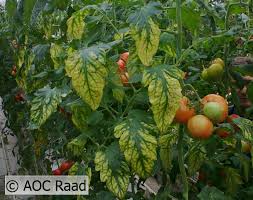To determine at the sight the exact cause of a disease or defect is not easy. Without research and experience virtually impossible. Many symptoms are the same: slow growth, yellowing leaves (pale or dry) spots on the leaves. This may indicate a lack of trace elements. That does not necessarily mean that those elements are not present, but they are not available in absorbable form. For example, because the soil is too acidic, or the temperature is too low. Also, inclusion of an element is influenced by the other elements.
An excess is often more harmful than a shortage.
A good, humus- rich soil normally contains sufficient amounts of all elements. You still suspect a defect, then provide additional fertilization: loose charcoal, chicken manure, or make liquid fertilizer from comfrey, and furnish this.
Shortage
 Boron: growing points die, inside stem and roots are brown, sometimes hollow and black. Mushy leaves turn yellow and then brown. (Excess boron can cause the same symptoms!)
Boron: growing points die, inside stem and roots are brown, sometimes hollow and black. Mushy leaves turn yellow and then brown. (Excess boron can cause the same symptoms!)
Calcium: general yellowing, even in young leaves. Slack cell walls.
Phosphorus: dwarfism, older leave is first dark green and purple, becomes yellow and dies.
Iron: young leaf yellowing (too little leaf green or chlorophyll created: chlorosis often occurs together with magnesium deficiency..), vein stays green. Points and edges dry.
Potassium: growth points and edges yellowing, leaf curling
Copper: leaf is blue-green, later yellow. Stem loosening.
Magnesium: fading leaf margins and between the veins. Older points and leaves remain green. Rapidly decaying leaves.
Manganese: grow slows down. Yellow speckles and spots of dead tissue.
Molybdenum: leave is yellow and deforms
Nitrogen: yellowing, limp leaves, older leaves turn red along the veins. Rapidly dying leaf falls off.
Zinc: young leaf yellowing, there are gaps between the veins which remain green. Leaf deviations/deformation.
Sulfur: uniform yellowing and then pink - purple discoloration.
